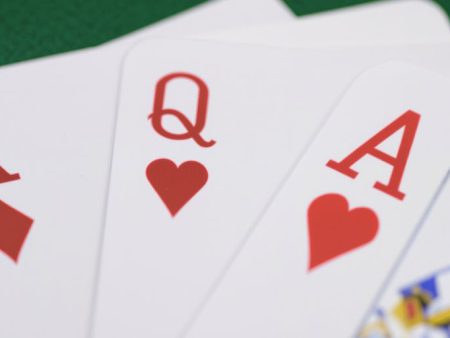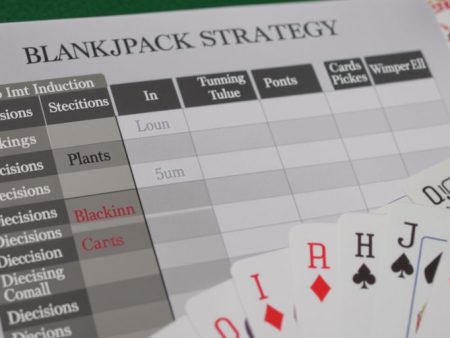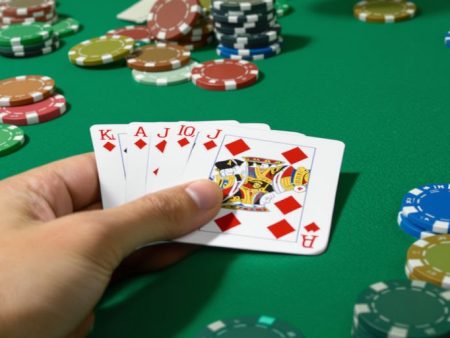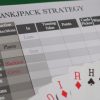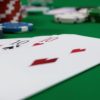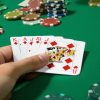So, you want to get better at blackjack? It’s a fun game, but knowing when to hit and when to stand can make a huge difference. It’s not just about luck; there’s a strategy involved. We’ll break down the basics so you can feel more confident at the table and maybe even walk away with more wins. Let’s figure out how to know when to hit or stand in blackjack.
Key Takeaways
- When your hand totals 11 or less, it’s always a good idea to hit because you can’t bust. If the dealer shows a 7 or higher, hitting with hands like 12-16 is often the smart move.
- Stand firm with a hard 17 or more, as hitting likely won’t help. Also, stand on 12-16 if the dealer shows a 5 or 6, as they have a higher chance of busting.
- Soft hands, especially those with an Ace, offer flexibility. Consider hitting or doubling down on Ace-6. For soft 13-18, doubling down when the dealer shows a 5 or 6 is often beneficial.
- Double down on 11 if the dealer shows 2-10, and on 10 when the dealer shows 9 or lower. This is a great way to capitalize on strong starting hands.
- Always split Aces and eights, but never split fives or tens. Avoid insurance bets altogether, as they usually don’t pay off in the long run.
Understanding When to Hit
Alright, let’s talk about when you absolutely need to grab another card in blackjack. It’s not just about hoping for a good number; it’s about making smart moves based on what you have and what the dealer is showing. Sometimes, you just gotta go for it, you know? It feels risky, but it’s often the mathematically sound play.
Hitting with Low Totals
If your hand adds up to 11 or less, you can’t possibly bust by hitting. Seriously, zero chance. So, why not take a swing? It’s a free shot at a better hand, and you’ve got nothing to lose. This is the easiest decision in blackjack, really. Just grab that card and see what happens. It’s like getting a free ticket to a better outcome.
Aggressive Hitting Against Strong Dealer Cards
Now, when the dealer is showing a seven or higher, things get a bit more intense. They’ve got a decent chance of making a strong hand, maybe even a 20 or 21. If your own hand is anything less than 17, you should seriously consider hitting. Don’t be shy! You need to improve your hand, and this is your best opportunity to do it before the dealer potentially gets a killer total. It’s a bit of a gamble, sure, but playing it safe here often means you’ll lose anyway.
When Your Hand is 12-16 vs. Dealer 7-Ace
This is where it gets tricky, and honestly, a little nerve-wracking. You’ve got a hand that’s decent, but not great, like 12, 13, 14, 15, or 16. The dealer, on the other hand, is showing a strong card – a 7, 8, 9, 10, Jack, Queen, King, or an Ace. What do you do? You hit. Yep, you hit. It feels wrong, I know. You’re one card away from busting. But the dealer’s upcard means they’re likely to make a hand of 17 or higher. If you stand pat with your 12-16, you’re almost guaranteed to lose to a dealer’s 17 or better. So, you take the risk. You hit, hoping for a low card, like a 2, 3, or 4, to get you to a respectable total without going bust. It’s a tough spot, but hitting is usually the play that gives you the best odds of not losing your shirt.
Strategic Standing Decisions
Knowing when to stand pat is just as important as knowing when to hit. It’s all about minimizing risk and letting the dealer potentially bust themselves out. Sometimes, the best move is to do nothing and let the cards fall where they may. It feels a bit passive, I know, but trust me, it’s a smart play.
Standing on Hard 17 or Higher
If your hand totals 17 or more, and it’s a “hard” total (meaning no Ace that can be counted as 1 or 11), you should absolutely stand. Seriously, don’t even think about hitting. The odds of getting a card that won’t make you bust are slim to none. You’ve got a strong hand, so let the dealer sweat it out. Even if the dealer is showing a face card or an Ace, your best bet is to stand firm. It’s a tough spot for them, not you.
Standing with 12-16 Against Dealer 5 or 6
This is where things get interesting. When you have a hand total between 12 and 16, and the dealer is showing a 5 or a 6, you want to stand. Why? Because those dealer upcards, a 5 or a 6, are the dealer’s weakest. They have a higher chance of busting out. You’ve got a decent hand, but not a guaranteed winner. By standing, you’re giving the dealer more opportunities to go over 21. It’s a calculated risk, but it often pays off. You’re basically letting the dealer do the hard work for you.
When Your Hand is 12-16 vs. Dealer 2-6
This is a bit of a broader rule, but it’s super important. If your hand is a hard 12 through 16, and the dealer’s upcard is a 2, 3, 4, 5, or 6, you should stand. These dealer upcards are considered weak because they give the dealer a higher probability of busting. Your hand might not be a powerhouse, but it’s strong enough to stand on when the dealer is in a vulnerable position. It’s all about playing the percentages. You’re not trying to hit a home run; you’re just trying to avoid striking out. It’s a solid strategy that’s saved me a lot of money over the years.
Mastering Soft Hands
Alright, let’s talk about those hands with an Ace. They’re called ‘soft’ because that Ace can be a 1 or an 11, giving you a bit more flexibility. It’s like having a secret weapon, but you gotta know how to use it right. Messing up a soft hand is a real bummer, trust me.
Hitting or Doubling Down on Aces-6
When you’ve got an Ace and a 6, that’s a soft 17. Now, what do you do? It really depends on what the dealer is showing. If the dealer has a 2, 3, 4, 5, or 6, you should totally double down. Why? Because the dealer is in a tough spot with those low cards, and you want to get more money on the table when you have a good chance. If the dealer shows anything else, like a 7 or higher, you should just hit. You need to improve that hand, plain and simple.
Doubling Down on Soft 13-18 vs. Dealer 5 or 6
This is where things get interesting. When you have a soft hand from Ace-2 (soft 13) all the way up to Ace-8 (soft 19), and the dealer is showing a 5 or a 6, you’ve got a golden opportunity to double down. This is especially true for soft 13 through soft 18. The dealer is weak with those upcards, meaning they’re more likely to bust. So, you want to double your bet and get more cash in your pocket. It’s a calculated risk, but the math backs it up. Don’t be shy here; go for it!
Here’s a quick look at what to do with those soft hands:
- Soft 13 (A-2): Double down vs. Dealer 5, 6. Hit otherwise.
- Soft 14 (A-3): Double down vs. Dealer 5, 6. Hit otherwise.
- Soft 15 (A-4): Double down vs. Dealer 4, 5, 6. Hit otherwise.
- Soft 16 (A-5): Double down vs. Dealer 3, 4, 5, 6. Hit otherwise.
- Soft 17 (A-6): Double down vs. Dealer 3, 4, 5, 6. Hit otherwise.
- Soft 18 (A-7): Double down vs. Dealer 2, 3, 4, 5, 6. Hit vs. Dealer 9, 10, Ace. Stand vs. Dealer 7, 8.
- Soft 19 (A-8): Double down vs. Dealer 6. Stand otherwise.
- Soft 20 (A-9): Always stand.
The Power of Doubling Down
Doubling down is a powerful move in blackjack, a chance to really boost your winnings when the odds are in your favor. It’s not just about betting more; it’s about making a smart, calculated decision to get that one extra card. When you double down, you’re essentially doubling your initial bet, but you only get one more card. If you win, you win double your original stake. It’s a high-stakes play, but oh so rewarding when it works out.
Doubling Down on 11 vs. Dealer 2-10
This is probably the most straightforward doubling opportunity. If your first two cards add up to 11, you’re in a fantastic spot. Why? Because there are a lot of cards that can give you a winning total, especially a 10-value card (10, Jack, Queen, King). If the dealer is showing a 2 through a 10, you should seriously consider doubling down. You’ve got a great shot at hitting 21 or a very strong 20. It’s a move that can really pay off.
Doubling Down on 10 vs. Dealer 9 or Lower
Having a total of 10 is also a strong starting point. If the dealer’s upcard is a 9, an 8, a 7, or lower, you’ve got a good chance to win. Again, you’re hoping for that 10-value card to get you to 20. The dealer’s weaker upcard means they’re more likely to bust or end up with a lower total. Doubling down here is a smart way to capitalize on that advantage. It’s a bit riskier than doubling on 11, but the potential reward is definitely there. You’re playing the probabilities, and when the dealer shows a weak card, you want to press your advantage.
Navigating Pairs
When you get a pair of cards that match in rank, like two 7s or two Kings, you have a special option: splitting them. This means you turn one hand into two, but you have to match your original bet on the second hand. It’s a game changer, really.
Always Split Aces and Eights
This is a big one, folks. If you’re dealt two Aces, you absolutely must split them. Each Ace is a great starting point, giving you a chance at 21. Don’t even think about not splitting them. It’s like leaving free money on the table. Same goes for a pair of eights. Two eights give you a total of 16, which is a pretty rough spot to be in. Splitting them gives you two hands starting with an 8, which is way better than facing that 16 against most dealer upcards. It’s a solid move, trust me.
When to Hit with Pairs of 2s or 3s
Now, pairs of 2s and 3s are a bit trickier. You don’t always split these. If the dealer is showing a 2 or a 3, splitting a pair of 2s or 3s is usually the way to go. You get two hands starting with a 2 or 3, and you can hit them. But if the dealer has a 4, 5, or 6 showing, splitting these pairs is still good. However, if the dealer shows anything higher, like a 7 or more, you should probably just hit your pair of 2s or 3s as a single hand. It’s all about what the dealer’s showing, you know? It’s a bit of a gamble, but the math works out.
Here’s a quick rundown for those pairs:
- Split Aces: Always. No exceptions.
- Split Eights: Always. Seriously, always.
- Split Twos/Threes: Split against dealer 2 through 7. Hit otherwise.
Remember, these are general guidelines. The specific rules of the table can sometimes change things a little, but sticking to these basics will put you way ahead of the game. It’s all about making smart choices, one hand at a time.
Dealer’s Upcard Influence

The dealer’s upcard is like a peek into their potential hand, and knowing how to react to it is super important. It’s not just about your cards; it’s a dance with what the dealer might have. Think of it as a weather report for the table. Some days are sunny, some are cloudy, and you gotta dress accordingly, right?
Dealer’s Weak Upcards (2-6)
When the dealer shows a card from a 2 to a 6, this is generally considered a weak upcard. Why? Because these cards mean the dealer has a higher chance of busting. They have to hit until they reach at least 17, and if they start with a 2, 3, 4, 5, or 6, they might end up with a total that’s too high. This is your golden opportunity to be a bit more aggressive with your own hand. You can often double down or stand on hands you might otherwise hit.
- With a total of 12 to 16, you should usually stand. The dealer is more likely to go over 21. It feels risky, but trust the math.
- If you have a soft hand (an Ace and another card), you can often hit or double down. Don’t be afraid to build your hand here.
- Pairs of 2s or 3s? You might want to hit if the dealer shows a 2 or 3. It’s a bit of a gamble, but it can pay off.
Dealer’s Strong Upcards (7-Ace)
Now, when the dealer shows a 7, 8, 9, 10, or an Ace, that’s a whole different ballgame. These are strong upcards. The dealer has a much better chance of making a good hand, often 17 or higher, without busting. This means you need to play more cautiously. You can’t afford to be too greedy with your own cards.
- If your hand totals 12 to 16, you should almost always hit. You need to try and improve your hand because the dealer is likely to beat whatever you have if you stand pat.
- A hand like Ace-7 (soft 18) is tricky. If the dealer shows a 9, 10, or Ace, you should hit. It’s a tough spot, but hitting is usually the better play.
- Never split 10s or face cards. Seriously, just don’t. It’s a common mistake that costs people money. Keep those 20s together!
Avoiding Costly Mistakes

Look, nobody’s perfect, and even the best players slip up sometimes. But there are some blunders that just seem to happen way too often, costing people money they didn’t need to lose. Let’s talk about a couple of big ones to steer clear of.
Never Split Fives or Tens
This one trips up a lot of folks. You get two fives, making a ten. Seems okay, right? But splitting them? That’s usually a bad move. You’re better off keeping that ten and hoping for a good card to make twenty. Same goes for tens. You’ve already got a solid twenty, a strong hand. Splitting tens is like throwing away a winning lottery ticket. Why would you do that? Never split a pair of fives or tens. It just doesn’t make sense mathematically.
Avoiding Insurance Bets
So, the dealer’s showing an Ace. They offer you insurance, a side bet that they have blackjack. It sounds safe, like you’re protecting your hand. But here’s the deal: statistically, this bet usually loses money in the long run. It’s a sucker bet, plain and simple. The odds are stacked against you. Unless you’re a card counter who knows the deck is loaded with tens, just say no. Stick to playing your hand; that’s where your focus should be.
Developing Your Blackjack Strategy

Alright, let’s talk about actually getting good at blackjack. It’s not just about luck, you know. You gotta have a plan. Think of it like chess, but with cards and a much cooler dealer. Developing a solid strategy is your ticket to not just playing, but playing smart. It’s about making the best decision possible with the cards you’re dealt and what the dealer’s showing. Forget just guessing; we’re talking about math and probabilities here.
Understanding Basic Strategy Charts
So, what’s this ‘basic strategy’ everyone talks about? It’s basically a set of rules, all worked out by mathematicians, that tells you the statistically best move for every single hand combination you can get against every possible dealer upcard. It sounds complicated, but it’s really just a guide. You’ll see charts that look a bit like a spreadsheet, and they’re your best friend. They take all the guesswork out of it. You look at your hand total, look at the dealer’s card, and bam, you know whether to hit, stand, double down, or split. Following these charts consistently is the single biggest thing you can do to lower the house edge. It’s not about feeling lucky; it’s about playing the odds.
Here’s a peek at what those charts might tell you:
- Your Hand: 12-16, Dealer’s Upcard: 2-6
- Decision: Stand. The dealer has a high chance of busting with these weaker upcards. Don’t risk busting yourself by hitting.
- Your Hand: 12-16, Dealer’s Upcard: 7-Ace
- Decision: Hit. The dealer’s upcard is strong. You need to improve your hand, even if it means risking a bust.
- Your Hand: 11, Dealer’s Upcard: 2-10
- Decision: Double Down. You’ve got a great chance of hitting a 10-value card and getting 21.
The Role of Mathematics in Decisions
This is where the real magic happens, or at least, where the smart plays are made. Blackjack isn’t just about the cards you get; it’s about the cards you might get. Basic strategy is built on probabilities. For example, when you have a total of 11, there are a lot of cards that can give you a strong hand (10s, Jacks, Queens, Kings, and Aces). That’s why doubling down on 11 against most dealer cards is such a good move. Conversely, if you have 16 and the dealer shows a 7, hitting is usually the better play because a 16 is a terrible hand to stand on, and the dealer’s 7 is strong. It’s all about calculating risk versus reward. You’re not trying to get exactly 21; you’re trying to make the best possible decision to win the hand, given the information you have. It’s a constant dance with probability, and the charts are your choreographer.
Advanced Techniques for Advantage
Ready to move beyond the basics? This is where things get really interesting. We’re talking about techniques that can actually shift the odds in your favor, giving you an edge over the house. It’s not magic, it’s math and observation, and it takes practice, but oh boy, can it pay off.
Introduction to Card Counting
So, card counting. It sounds like something out of a spy movie, right? But it’s really just a way to keep track of what cards have been played. The idea is simple: when more high cards (10s, face cards, Aces) are left in the deck, your chances of getting a blackjack or a strong hand go up. Conversely, if only low cards are left, the dealer’s chances of busting increase. You assign a point value to each card as it’s dealt. For example, a common system is to give cards 2-6 a +1, cards 7-9 a 0, and cards 10-Ace a -1. As you play, you keep a running count. A positive count means more good cards are left, and a negative count means the opposite. When the count is high and positive, you increase your bets. It’s not about knowing exactly what card is coming next, but about knowing the probability of good cards remaining. It takes a lot of focus and practice, and casinos definitely keep an eye out for players who seem to be doing it. Don’t expect to master this overnight; it’s a skill that develops over time.
Understanding Side Bets and Their Risks
Many blackjack tables offer side bets, like "21+3" or "Perfect Pairs." These can be fun, adding a little extra spice to your game. "Perfect Pairs" pays out if you get a pair of the same rank and color, or just the same rank. "21+3" combines your first two cards with the dealer’s upcard to make a poker hand. Sounds exciting, doesn’t it? The catch? These side bets almost always come with a much higher house edge than the main blackjack game. That means, statistically, you’re more likely to lose money on them over the long run. Think of them as entertainment, a little bonus if you’re feeling lucky, but not a reliable way to boost your overall winnings. If your goal is to maximize your advantage, stick to the main game and maybe a bit of card counting. If you just want some extra thrills, go for it, but know the risks involved.
Practical Application and Mindset

Alright, so you’ve been studying the charts, you know when to hit and when to stand, and you’re feeling pretty good about your game. That’s awesome! But knowing the strategy is only half the battle, right? Actually putting it into practice, especially when the chips are on the table and the dealer’s looking at you, that’s where the real fun begins. It’s not just about memorizing moves; it’s about making them happen, consistently.
Practicing Your Skills
Look, nobody becomes a blackjack whiz overnight. It takes reps. Lots of them. Think of it like learning an instrument or a new sport. You wouldn’t just read a book about basketball and then expect to sink three-pointers in a real game, would you? Blackjack is the same way. You gotta get that muscle memory going.
- Start Small: Hit up those tables with the lowest minimum bets. Seriously, this is your training ground. You can play more hands, get a feel for the flow of the game, and see how the dealer operates without breaking the bank. It’s a low-pressure way to get your feet wet.
- Online Practice: There are tons of free blackjack games online. Use them! They’re great for drilling basic strategy without any real-world consequences. You can play hundreds, even thousands, of hands and really start to internalize those decisions.
- Visualize: Even when you’re not at a table, close your eyes and picture a hand. What’s your total? What’s the dealer showing? What’s the correct play? Running through scenarios in your head can be surprisingly effective.
Don’t get discouraged if you make mistakes. Everyone does, especially at first. The key is to learn from them. Did you hit when you should have stood? Okay, make a mental note. Next time, you’ll remember. It’s a process, and every hand is a chance to get a little bit better.
Maintaining a Positive and Focused Mindset
This is huge, and honestly, it’s probably the hardest part for a lot of people. Blackjack can be a rollercoaster. You’ll have winning sessions, and you’ll have losing sessions. That’s just how probability works. The trick is not to let the bad beats get you down or make you play sloppy.
- Emotional Control: If you just lost a big hand, resist the urge to immediately chase your losses or make impulsive bets. Take a breath. Stick to your strategy. Letting emotions dictate your play is a fast track to losing more money.
- Focus on the Process: You can’t control the cards you’re dealt, but you can control how you play them. Concentrate on making the correct strategic decision for each hand, regardless of the outcome. That’s how you win in the long run.
- Enjoy the Game: Remember why you started playing. It’s supposed to be fun! If you’re not enjoying yourself, it’s probably time for a break. A clear head makes for better decisions. Don’t let the pursuit of wins overshadow the enjoyment of playing a great game.
Think of each session as a chance to apply what you’ve learned. Some days the cards will fall your way, and some days they won’t. But if you stick to your strategy and keep a level head, you’ll be setting yourself up for success more often than not. It’s a marathon, not a sprint, and a good mindset is your best running shoes.
Putting It All Together for Blackjack Success
So, we’ve gone over when to hit and when to stand, and it really comes down to knowing the dealer’s upcard and what you’ve got in your hand. It’s not rocket science, but it does take some practice. Don’t expect to be a pro overnight. Keep these basic rules in mind, maybe play a few practice rounds online, and you’ll start to see a pattern. Remember, the goal is to make smart choices based on the odds, not just gut feelings. Stick with it, and you’ll definitely feel more confident at the blackjack table, hopefully leading to some nice wins.
Frequently Asked Questions
When is it smart to hit in blackjack?
It’s usually a good idea to hit if your cards add up to 11 or less. You can’t go over 21 by hitting at this point, so there’s no risk in taking another card.
When should you stand with your hand?
You should stand if your hand’s total is 17 or more. Trying to hit again would likely make you go over 21. It’s better to keep your current hand, even if the dealer has a strong card showing.
When should you stand with a hand of 12-16 against a dealer’s 5 or 6?
If you have a hand totaling 12 to 16, and the dealer is showing a 5 or 6, it’s best to stand. These dealer cards are weak, meaning the dealer is more likely to go over 21. Standing gives you a better chance to win.
Should you always split Aces and 8s?
When you get two Aces or two 8s, always split them. Splitting Aces gives you two chances to get a strong hand, and splitting 8s helps you avoid a weak total of 16.
When should you not split pairs?
You should never split a pair of 5s or 10s. For 5s, it’s better to hit or double down. For 10s, you already have a strong hand of 20, so splitting would likely weaken it.
Should you ever take an insurance bet?
You should avoid insurance bets. While it might seem like a good idea when the dealer shows an Ace, it’s a bet that usually doesn’t pay off in the long run and can hurt your winnings.
When is doubling down on 11 a good move?
It’s smart to double down when your initial two cards add up to 11, especially if the dealer shows a card from 2 to 10. You get one more card, and with an 11, you have a great chance of getting a 10-value card for a total of 21.
Is practicing important for getting better at blackjack?
Yes, practicing your skills is key! You can play online or with friends to get better. Learning basic strategy and managing your money wisely will help you win more often.
